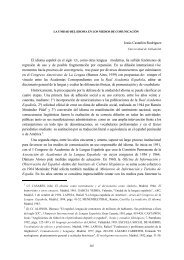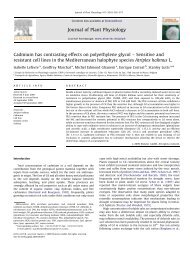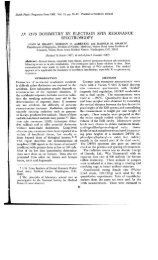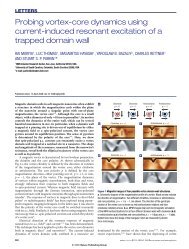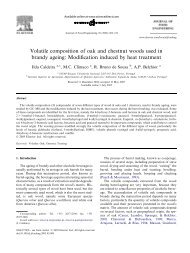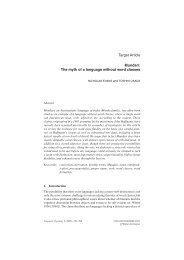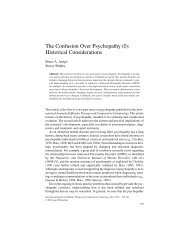Terpenoids: Opportunities for Biosynthesis of Natural Product Drugs ...
Terpenoids: Opportunities for Biosynthesis of Natural Product Drugs ...
Terpenoids: Opportunities for Biosynthesis of Natural Product Drugs ...
You also want an ePaper? Increase the reach of your titles
YUMPU automatically turns print PDFs into web optimized ePapers that Google loves.
<strong>Terpenoids</strong>: <strong>Biosynthesis</strong> <strong>of</strong> <strong>Natural</strong> <strong>Product</strong> <strong>Drugs</strong> reviews<br />
mevalonate pathway was incorporated that increased lycopene<br />
production 2-fold (the heterologous mevalonate pathway<br />
will be discussed below).<br />
Model-based rational manipulations and library screening<br />
were used to increase the supplies <strong>of</strong> G3P, PEP, reducing<br />
equivalents, and energy carriers (ATP, GTP, CTP, etc.). A<br />
computational search using a stoichiometric, genomewide<br />
bioreaction model <strong>of</strong> E. coli metabolism was used to identify<br />
gene knockouts which are predicted to increase the flux to<br />
lycopene by eliminate competing reactions or providing more<br />
energy or reducing equivalents <strong>for</strong> the pathway. 195 By using<br />
a sequential approach, the model was able to predict single<br />
and multiple gene knockout, including a triple knockout<br />
construct deleting the genes <strong>of</strong> gdhA/aceE/fdhF. This predicted<br />
strain was created in the background <strong>of</strong> the dxs, idi,<br />
and ispDF overexpression strain and was experimentally<br />
validated to produce the highest yield, 6,600 ppm, 37% above<br />
that <strong>of</strong> the parental strain. The stoichiometric model-based<br />
method can account only <strong>for</strong> stoichiometric effects on<br />
lycopene production; as such it cannot predict important<br />
kinetic and regulatory effects that may affect lycopene<br />
production.<br />
Different combinatorial approaches (commonly called<br />
inverse metabolic engineering) have been used to identify<br />
genetic changes that are not predicted by current understanding<br />
<strong>of</strong> terpenoid metabolism. A transposon mutagenesis<br />
library, which has a transposon sequence randomly inserted<br />
in the genome <strong>of</strong> each mutant, thereby inactivating the gene<br />
it lands in, was used to search <strong>for</strong> additional knockout targets<br />
that affect the lycopene phenotype via regulatory, kinetic,<br />
or other unknown mechanisms. 196 The screening <strong>of</strong> the<br />
transposon library identified three gene targets, rssB (hnr),<br />
(199) Kang, M. J.; Lee, Y. M.; Yoon, S. H.; Kim, J. H.; Ock, S. W.;<br />
Jung, K. H.; Shin, Y. C.; Keasling, J. D.; Kim, S. W.<br />
Identification <strong>of</strong> genes affecting lycopene accumulation in<br />
Escherichia coli using a shot-gun method. Biotechnol. Bioeng.<br />
2005, 91 (5), 636–642.<br />
(200) Ruther, A.; Misawa, N.; Böger, P.; Sandmann, G. <strong>Product</strong>ion<br />
<strong>of</strong> zeaxanthin in Escherichia coli with different carotenogenic<br />
plasmids. Appl. Microb. Biotechnol. 1997, 48, 162–167.<br />
(201) Albrecht, M.; Takaichi, S.; Misawa, N.; Schnurr, G.; Boger, P.;<br />
Sandmann, G. Synthesis <strong>of</strong> atypical cyclic and acyclic hydroxy<br />
carotenoids in Escherichia coli trans<strong>for</strong>mants. J. Biotechnol.<br />
1997, 58 (3), 177–185.<br />
(202) Lee, P. C.; Momen, A. Z.; Mijts, B. N.; Schmidt-Dannert, C.<br />
<strong>Biosynthesis</strong> <strong>of</strong> structurally novel carotenoids in Escherichia coli.<br />
Chem. Biol. 2003, 10 (5), 453–462.<br />
(203) Yoon, S. H.; Lee, Y. M.; Kim, J. E.; Lee, S. H.; Lee, J. H.;<br />
Kim, J. Y.; Jung, K. H.; Shin, Y. C.; Keasling, J. D.; Kim, S. W.<br />
Enhanced Lycopene <strong>Product</strong>ion in Escherichia coli Engineered<br />
to Synthesize Isopentenyl Diphosphate and Dimethylallyl Diphosphate<br />
From Mevalonate. Biotechnol. Bioeng. 2006, 94 (6), 1025–<br />
1032.<br />
(204) Yoon, S. H.; Kim, J. E.; Lee, S. H.; Park, H. M.; Choi, M. S.;<br />
Kim, J. Y.; Lee, S. H.; Shin, Y. C.; Keasling, J. D.; Kim, S. W.<br />
Engineering the lycopene synthetic pathway in E. coli by<br />
comparison <strong>of</strong> the carotenoid genes <strong>of</strong> Pantoea agglomerans and<br />
Pantoea ananatis. Appl. Microbiol. Biotechnol. 2007, 74, 131–<br />
139.<br />
yjfP, and yjiD, that correlated with lycopene overproduction.<br />
In the case <strong>of</strong> yjiD, the transposon was inserted between the<br />
identified promoter region and the gene <strong>for</strong> yjiD (notated as<br />
∆pyjiD).<br />
Further attempts were made to combine the rationally<br />
identified gene targets with combinatorial gene targets. Using<br />
the two distinct sets <strong>of</strong> (1) stoichiometric (discovered by the<br />
computational model) and (2) combinatorial gene targets<br />
(identified from the transposon library) identified in the above<br />
study, a global maximal strain with triple knockout<br />
∆gdhA∆aceE∆pyjiD was generated. 196 It is interesting to<br />
note that this global optimum strain contained two targets<br />
from the stoichiometric model and one from the combinatorial<br />
library. This optimum would not have been found<br />
without using these two approaches in combination. Under<br />
optimized conditions, this lycopene producing strain accumulated<br />
lycopene up to 18,000 ppm in shake flask and<br />
220 mg/L from a 27 g DCW/L, high-cell-density fed-batch<br />
fermentations. 197<br />
Another combinatorial approach, involving the overexpression<br />
<strong>of</strong> random genes in the E. coli genome, was carried<br />
out in the computational model-based gdhA/aceE/fdhF strain.<br />
This search strategy screened genomic libraries <strong>of</strong> E. coli<br />
and identified two hypothetical regulatory genes, yjiD and<br />
ycgW, that improved lycopene production. 198 The final<br />
lycopene engineered strain included four overexpressions and<br />
three knockouts, (T5P-dxs, T5P-idi, rrnBP-yjiD-ycgW,<br />
∆gdh∆aceE∆fdhF, pACLYC) which might exhibit three<br />
different mechanisms <strong>for</strong> improving lycopene production:<br />
push, pull, and global regulation favoring lycopene production.<br />
First, the strain contained three knockouts <strong>of</strong> metabolic<br />
enzymes in the central carbon metabolism, which might push<br />
precursors into the non-mevalonate pathway. Second, the<br />
strain had overexpressions <strong>of</strong> two isoprenoid pathway genes<br />
which pull precursor metabolites from a central metabolic<br />
pathway into the non-mevalonate pathway. Finally, the strain<br />
also overexpresses two hypothetical proteins, which presumably<br />
affect lycopene production through a regulatory manner.<br />
In another library overexpression approach, Kang et al. 199<br />
identified another set <strong>of</strong> genes enhancing lycopene production<br />
in E. coli. They identified three regulatory genes such as<br />
crl, rpoS, and appY, which could act as enhancers <strong>of</strong><br />
lycopene production when expressed alone or coexpressed<br />
with the rate-limiting gene <strong>of</strong> dxs in the MEP pathway. The<br />
combination <strong>of</strong> dxs with crl, rpoS, and appY produced 4.7<br />
mg/g dry cell weight <strong>of</strong> lycopene, which is significantly<br />
higher than that <strong>of</strong> overexpressing dxs alone.<br />
Engineering Heterologous Mevalonate Pathway To<br />
Provide the Universal Precursors IPP/DMAPP. To address<br />
the precursor limitations, an E. coli strain was<br />
engineered with the heterologous mevalonate pathway to<br />
yield large amounts <strong>of</strong> the terpenoid precursors, resulting in<br />
a high-level, in ViVo production <strong>of</strong> amorphadiene, the<br />
sesquiterpene olefin precursor to the potent antimalarial drug<br />
artemisinin. 179 By engineering the expression <strong>of</strong> a synthetic<br />
amorpha-4,11-diene synthase gene and introducing the<br />
mevalonate pathway from Saccharomyces cereVisiae into the<br />
VOL. 5, NO. 2 MOLECULAR PHARMACEUTICS 185



